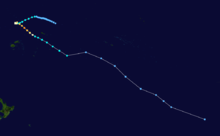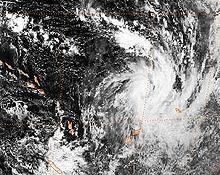- Cyclone Keli
-
Severe Tropical Cyclone Keli Category 3 cyclone (Australian scale) Category 4 Tropical Cyclone (SSHS) Cyclone Keli at peak intensity. Formed June 07, 1997 Dissipated June 17, 1997 Highest winds 10-minute sustained:
150 km/h (90 mph)
1-minute sustained:
215 km/h (130 mph)Lowest pressure 955 mbar (hPa; 28.2 inHg) Fatalities None reported Damage $10,000 (1997 USD) Areas affected Tokelau, Tuvalu, Fiji Part of the 1996–97 South Pacific cyclone season, Severe Tropical Cyclone Keli (NPMOC/JTWC Designation: 38P) was the first recorded post-season tropical cyclone to form in June within the South Pacific Ocean.[1][2] The system formed on June 7, 1997, about 460 kilometers (285 mi) to the north of Tokelau. The depression gradually developed over the next few days while moving southwestward. It was designated as Tropical Cyclone Keli early the next day. Cyclone Keli intensified, slowly reaching its 10-minute peak wind speeds of 150 km/h, (90 mph), which made it a Category 3 severe tropical cyclone on the Australian Tropical Cyclone Intensity Scale. As it came under the influence of strong mid latitude westerlies and moved into an area of strong vertical wind shear, the cyclone started to weaken and was declared as extratropical on June 15.
Cyclone Keli struck the islands of Tuvalu on June 12 and 13, with extensive damage reported throughout the Islands with trees uprooted by wind and waves. On Nivalakita all buildings except for the church were flattened; an estimated cost to rebuild all of the houses as they were before the cyclone hit was estimated at AU$12 thousand (US$10 thousand), while it was estimated that the cost of rebuilding the houses with an improved, cyclone-resistant design would be about AU$84 thousand (US$63 thousand). The whole of Tepuka Savilivili was left uninhabitable, as coconut trees and other vegetation were swept away with no more than an area of jagged coral left behind. In Fiji, strong winds and rough seas were reported from the cyclone as it was moving to the north of Fiji, and while the cyclone was weakening it dropped 3.76 inches (95.5mm) of rain on American Samoa.
Contents
Meteorological history
Early on June 7, the Regional Specialized Meteorological Center (RSMC) in Nadi, Fiji reported that a tropical depression had formed about 460 kilometres (285 mi) to the north of Tokelau.[3] Over the next couple of days the depression moved to the south-west and gradually developed, with a tropical cyclone formation alert being issued early on June 9 by the Naval Pacific Meteorology and Oceanography Center (NPMOC), with the depression expected to intensify into a tropical cyclone within 24 hours.[3][4] Early the next day both RSMC Nadi and the NPMOC reported that the depression had intensified into a tropical cyclone.[3][4] RSMC Nadi assigned the name Keli to the cyclone while it was located about 1210 km (750 mi) to the north-east of Nadi.[3] At the same time the NPMOC assigned the designation of 38P to the Cyclone with wind speeds that were equivalent to a tropical storm.[4] Later that day RSMC Nadi reported that the cyclone had intensified further and had become a Category 2 tropical cyclone on the Australian tropical cyclone intensity scale.[3]
Early on June 11 as Keli crossed the International Dateline; the NPMOC reported that the organisation and outflow of Keli was good and that they were expecting the cyclone to intensify slowly before affecting Tuvalu.[4] They then passed warning responsibility of Keli to the Joint Typhoon Warning Center (JTWC) later that day. As the JTWC started to issue warnings they reported that the cyclone had intensified into a category one tropical cyclone on the Saffir–Simpson Hurricane Scale (SSHS) while RSMC Nadi reported that it had become a Category 3 severe tropical cyclone as the cyclone started to move around Tuvalu.[3][4] As it moved around Tuvalu a mid level trough was forecast to approach the system from the west and push Keli to the south.[4] RSMC Nadi then reported early the next day that Keli had recrossed the dateline and had reached its 10-minute peak wind speeds of 150 km/h, (90 mph).[3] However the JTWC did not report until later that day that Keli has reached its 1-minute peak wind speeds of 215 km/h (130 mph), which made it a Category 4 tropical cyclone on the SSHS after rapidly intensifying in an area of low vertical windshear.[4] The JTWC then passed the warning responsibility for Keli back to the NPMOC as it came under the influence of strong mid latitude westerlies which were expected to weaken the system.[4]
During June 13 both RSMC Nadi and the NPMOC reported that Keli had weakened as it began to experience vertical windshear from the north-west as it started the transition into an extra-tropical cyclone.[3][4] At this time RSMC Nadi reported that the system had become a Category 2 cyclone while the JTWC downgraded Keli to a tropical storm as it was located about 400 km (250 mi) to the south-east of the Samoan Islands.[3][4] During June 14, RSMC Nadi downgraded the cyclone to a Category 1 cyclone before it was declared extra-tropical by the JTWC early the next day as it had started to accelerate to the south-east while RSMC Nadi downgraded it to a Tropical Depression.[3][4] RSMC Nadi then continued to issue warnings on the depression until early on June 16 when they passed primary warning responsibility of Keli to TCWC Wellington, as the depression had passed to the south of 25S and had entered TCWC Wellington's area of responsibility.[3] TCWC Wellington continued to monitor the depression until early the next day when they issued their last advisory.[3]
Differences among warning centres
The Regional Specialized Meteorological Center in Nadi, Fiji uses the Australian Tropical Cyclone Intensity Scale which is based on 10-minute sustained winds and three second gusts for its tropical cyclone tracking information, while both the Joint Typhoon Warning Center and the Naval Pacific Meteorology and Oceanography Center use 1-minute sustained winds.[5] The conversion factor between the two is 1.14.[6] RSMC Nadi's peak intensity for Keli was 150 km/h, (90 mph) 10-minute sustained, or 170 km/h (105 mph) 1-minute sustained.[3][6] The JTWC's peak intensity for Keli was 215 km/h (130 mph) 1-minute sustained, or 190 km/h (120 mph) 10-minute sustained.[6][7]
Impact and aftermath
Tuvalu
As Cyclone Keli struck the islands of Tuvalu on June 12 and 13, peak wind gusts of 165 km/h, (105 mph) were reported, with extensive damage also reported throughout the Islands with trees uprooted by wind and waves.[8] On Nivalakita all buildings except for the church were flattened with an estimated cost to rebuild the houses exactly as they were was estimated at AU$12,000 (US$10,000 1997), while it was estimated that the cost of rebuilding the houses with an improved, cyclone-resistant design would be about AU$84,000 (63,000 USD 1997).[9] Also on Nivalakita communications were cut with the telephone operator having to resort to sending a Morse code message, however as the storm re-curved and re-hit Tuvalu on June 14, it silenced the weak radio telegraph system.[8] In Tepuka Savilivili the whole island was left uninhabitable as coconut trees and other vegetation were swept away with no more than an area of jagged coral left behind.[10][11]
A New Zealand air force plane was sent to pick up and deliver aid sent by Fiji, France, New Zealand and Australia after reports that the inhabitants of Niualakita atoll were desperately short of water, food and shelter.[12][13][14] The plane flew over one of the atolls affected and reported seeing widespread damage, with loads of trees and flattened buildings. Locals waved from the beach as the plane flew overhead as they had been cut off from the outside world for five days.[15][16][17]
Elsewhere
Damage was also reported in Samoa and Wallis and Futuna whilst the storm also produced strong winds, rough seas and heavy swells in Fiji.[2][18] 3.76 inches (95.5 mm) of rain was reported in Afono, American Samoa.[19]
After the season ended, it was announced that the name Keli would be retired from RSMC Nadi's List of tropical cyclone names and would be replaced with the name of Kofi.[20][21]
See also
- 1996–97 South Pacific cyclone season
References
- ^ "Tropical Cyclone Information for the Southern Hemisphere". Bureau of Meteorology. 2009. http://www.bom.gov.au/cgi-bin/silo/cyclones_sh.cgi. Retrieved 2009-08-31.
- ^ a b "Asia-Pacific Workshop on Indicators and Indices for Monitoring Trends in Climate Extremes". Bureau of Meteorology. 1998-12-10. p. 43. http://www.bom.gov.au/bmrc/csr/apn/papers/APNreport,1998.doc. Retrieved 2009-08-26.
- ^ a b c d e f g h i j k l m "South Pacific Tropical Cyclone Best Track". Fiji Meteorological Service, Meteorological Service of New Zealand Limited. NOAA. 2009-05-22. ftp://eclipse.ncdc.noaa.gov/pub/ibtracs/original-bt-data-files/wellington/TC_BT_1967_2006.xls. Retrieved 2009-08-07.
- ^ a b c d e f g h i j k "Tropical Cyclone Keli Advisories". Naval Pacific Meteorology and Oceanography Center/Joint Typhoon Warning Center. Australian Severe Weather. 2009. http://www.australiasevereweather.com/cyclones/1997/keli.htm. Retrieved 2009-08-07.
- ^ Joint Typhoon Warning Center (2008-03-31). "Frequently Asked Questions". United States Navy. http://www.usno.navy.mil/JTWC/frequently-asked-questions-1#fcstdiff. Retrieved 2009-06-29.
- ^ a b c "Section 2 Intensity Observation and Forecast Errors". United States Navy. 2009. http://www.nrlmry.navy.mil/~chu/chap6/se200.htm. Retrieved 2009-06-29.
- ^ "JTWC/NPMOC Tropical Cyclone Best Track: 38P". Joint Typhoon Warning Center. 2002-12-17. http://www.usno.navy.mil/NOOC/nmfc-ph/RSS/jtwc/best_tracks/1997/1997s-bsh/bsh381997.txt. Retrieved 2009-08-31.
- ^ a b Steve Newman (1997-06-24). "EARTHWEEK: A diary of the planet". The Gainesville Sun. http://news.google.com/newspapers?nid=1320&dat=19970624&id=8wASAAAAIBAJ&sjid=2OoDAAAAIBAJ&pg=1481,5373215. Retrieved 2009-08-30.
- ^ Emily M (2006-03-17). "Tool One: Guidelines for estimating the economic impact of natural disasters". Aus Aid. http://www.ausaid.gov.au/publications/pdf/impact_pacific_tools.pdf. Retrieved 2009-08-30.
- ^ Bikenibeu Paeniu (1997-12-07). "Tuvalu and Global Warming". Tuvalu Islands. http://www.tuvaluislands.com/kyoto-panieu.htm. Retrieved 2009-08-30.
- ^ Angie Knox (2002-08-28). "Sinking feeling in Tuvalu". BBC News. http://news.bbc.co.uk/1/hi/world/asia-pacific/2219001.stm. Retrieved 2009-08-30.
- ^ "Neighbours fly aid to cyclone-hit island in South Pacific". Wellington, New Zealand: Dateline AM cycle. 1997-06-14.
- ^ "Urgent aid being flown to cyclone-hit Tuvalu". Associated Press Worldstream (Wellington, New Zealand: Dateline PM cycle). 1997-06-13.
- ^ "Neighbours fly aid to cyclone-hit island in South Pacific". Wellington, New Zealand: Dateline pm cycle. 1997-06-14.
- ^ "New Zealand crew reports widespread damage on Tuvalu atoll". Wellington, New Zealand: Dateline. 1997-06-16.
- ^ "Damage still undetermined on cyclone-hit Tuvalu". Associated Press Worldstream (Wellington, New Zealand: Dateline). 1997-06-15.
- ^ "Aid on way to cyclone struck isle". The Register Guard (Guard Publishing Company). 1997-06-15. http://news.google.com/newspapers?id=5YIVAAAAIBAJ&sjid=8usDAAAAIBAJ&pg=6559,3805855&dq=cyclone+keli. Retrieved 2009-08-30.[dead link]
- ^ "Cyclone Keli might force a cancellation of Saturday's". Agence France Presse. 1997-06-14.
- ^ David Roth (2009-08-30). "Tropical Cyclone Rainfall Maxima". National Oceanic and Atmospheric Administration. http://www.hpc.ncep.noaa.gov/tropical/rain/tcmaxima.html. Retrieved 2009-08-30.
- ^ "Tropical Cyclone Operational Plan for the Southwest Indian Ocean and the Southern Pacific Ocean". RA V Tropical Cyclone Committee. World Meteorological Organization. 2009-03-10. http://www.wmo.int/pages/prog/www/tcp/documents/TCP24-English2008.pdf. Retrieved 2009-05-21.
- ^ "Tropical cyclone names: Fiji". Met Office. 2009-08-30. http://www.metoffice.gov.uk/weather/tropicalcyclone/names.html. Retrieved 2009-08-30.
External links
1970s 1980s 1990s 2000s 2010s Tropical cyclones of the 1996–97 South Pacific cyclone season
CFeDEFHUnGHIJ38KSouth Pacific Tropical Cyclone Scale TDI TDE 1 2 3 4 5  Book ·
Book ·  Category ·
Category ·  Portal ·
Portal ·  WikiProject ·
WikiProject ·  CommonsCategories:
CommonsCategories:- Retired South Pacific cyclones
- 1996–97 South Pacific cyclone season
- Tropical cyclones in Fiji
- Tropical cyclones in American Samoa
- Category 3 South Pacific cyclones
Wikimedia Foundation. 2010.



